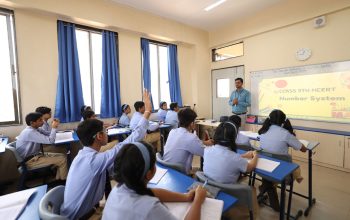As parents, we know the vital role that literacy plays in our children’s lives in almost everything related to academics. It is also crucial in sectors of psychological and social development. The ability to recognize letters is a foundational skill that leads the way to reading. It is also a base talent required when it comes to writing and communication. It also boosts a child’s self-esteem as they feel competent and invested in the process.
Through this post, we aim to discuss the significance of letter recognition at both grade levels and pre-school Singapore levels. The post will also give you tips on how parents can be a big part of a child’s journey towards reading.
The Foundation of Literacy: Letter Recognition
What is Letter Recognition?
The capacity to recognize and distinguish between individual alphabetic letters is known as letter recognition. It entails identifying the names, sounds, and forms that correspond to each letter.
As a precondition to reading and writing, letter recognition is a fundamental ability in the early literacy development process. Children may recognize letters in printed text, environmental print, digital media, and other situations by learning letter recognition.
This ability develops phonemic awareness and vocabulary in a pre-school Singapore. This, in turn, improves reading comprehension and fluency. In educational contexts, interactive activities and multisensory experiences are commonly used to introduce and reinforce letter recognition.
Importance of Letter Recognition:
- Reading Readiness: A prerequisite for reading without trouble is letter recognition. Children who can pick out letters accurately are prepared to decode phrases. They must realize textual content after they start formally studying education.
- Writing Skills: Understanding letters lets teenagers train them in writing. It trains them in forming the basis of spelling and handwriting proficiency. Letter popularity is crucial for forming letters successfully and spelling phrases as they should be.
- Language Development: Letter acceptance fosters language development by increasing children’s vocabulary. It increases phonemic awareness and information on letter-sound correspondences. It allows them to make connections between letters, sounds, and phrases.
- Academic Success: Proficiency in letter recognition is connected to academic achievement across various topics. The success is together with language arts, mathematics, and science. Strong literacy competencies are important for studying and vital questioning.
Letter Recognition in the Pre-school Singapore
Strategies for Teaching Letter Recognition in Pre-school:
- Multi-Sensory Activities: Engage children in activities with multi-sensory sports together with letter puzzles. You can also use sensory books and alphabet video games. Incorporate physical substances like sandpaper letters or foam letters to offer physical support.
- Songs and Rhymes: Use catchy songs and rhymes to introduce letters and their corresponding sounds. Singing alphabet songs or reciting rhymes could make letter recognition exciting and remarkable for young children.
- Visual Aids: Display alphabet charts and flashcards inside the study room and at home to provide visual support. Encourage kids to perceive letters in their environment, which includes labels and books.
- Literacy-rich Environment: Create print-rich surroundings with books & magazines. You can also use labels that disclose kids to letters and phrases in context. Encourage storytelling and reading aloud stories to foster a love of literacy.
Letter Recognition in Secondary Education
Reinforcing Letter Recognition Skills in Secondary Students Based on Secondary School Fees:
- Literacy Across Subjects: You must emphasize the importance of literacy competencies throughout all topics, not simply language arts. Try to encourage students to interact with textual content in technological knowledge. The records and arithmetic training will also reinforce their letter popularity talents in context.
- Vocabulary Development: Expand students’ vocabulary and word popularity by using challenging texts and educational vocabulary. Encourage independent studying and offer opportunities for vocabulary upgrading through discussions and writing sports.
- Reading Command: Develop students’ studying command skills by coaching them on techniques for decoding unusual words. Try to make them figure out fundamental ideas and make interpretations. Encourage energetic reading through annotation and dialogue.
- Writing Proficiency: Support students’ writing improvement by presenting opportunities for practice and remarks. You must emphasize the significance of spelling accuracy. Try to highlight the use of grammar and punctuation in written information.
Enforce all these points for proper letter recognition in your kids with better knowledge of secondary school fees in learning.
How Parents Can Support Letter Recognition at Home
It is very important for parents to support their kids in their education. Kids need support and guidance with praise to be guided in the right direction. With proper direction & spending secondary school fees, your child will have no problem with letter recognition.
- Read Together: Teach your child to read on a regular basis with you by sharing books daily. Select age-related books that are suitable for your children. Have conversations with them that cover the story as well as the plot.
- Letter Games: Playing the “I Spy” game or alphabet bingo are good examples of letter recognition games. Letter scavenger hunt is another option worth considering. Let learning to make letters exciting and enjoyable.
- Write Together: Try to persuade your kid to work on the writing skill through exercises like drawing. You could make them trace or write in sand. Even using shaving cream or other means can make your child learn to write better.
- Use Technology: Delve into educational apps and internet sites along with the cost of secondary school fees. Use interactive games to not only recall letters but also to reinforce the skill in fun. Think of exciting ways to teach your little ones that early education can be a lot of fun, too.
- Provide Encouragement: Congratulate your child for his or her progress with letters. Remember to encourage them all the time, even when they mess up. Extend acknowledgement or encouragement always to build their autonomy and inspiration.
The Concluding Thought:
One of the key abilities that sets the stage for reading and academic achievement is the identification of letters. Parents and educators may enable children to become confident readers and communicators by fostering letter recognition abilities in both pre-school Singapore and secondary settings.
Children in Singapore can acquire excellent letter recognition abilities that will lay the groundwork for a lifetime. For learning and success in studies, stimulating activities and a nurturing learning environment are used. At GIIS, you make your child learn and educate in the right manner with letter recognition methods in play.




